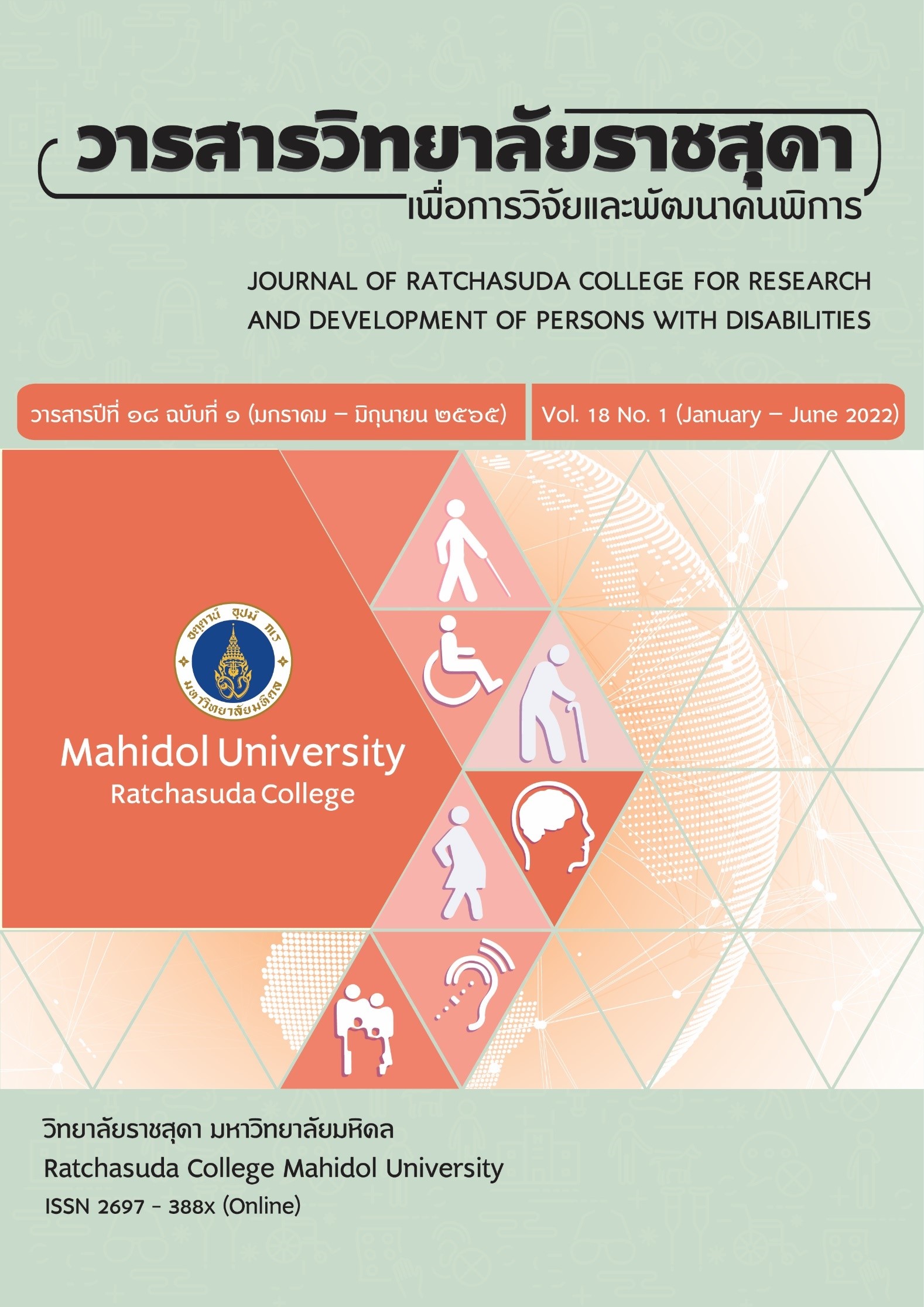การวิจัยและพัฒนาบทเรียนออนไลน์สาระภูมิศาสตร์ผ่านระบบจัดการ การเรียนรู้สำหรับนักเรียนที่มีความบกพร่องทางการได้ยิน ระดับมัธยมศึกษาตอนปลาย
คำสำคัญ:
นักเรียนที่มีความบกพร่องทางการได้ยิน, บทเรียนออนไลน์, ระบบจัดการการเรียนรู้บทคัดย่อ
การวิจัยนี้มีวัตถุประสงค์เพื่อวิจัยและพัฒนาบทเรียนออนไลน์ กลุ่มสาระการเรียนรู้สังคมศึกษา ศาสนา และวัฒนธรรม สาระภูมิศาสตร์ ผ่านระบบจัดการการเรียนรู้ สำหรับนักเรียนที่มีความบกพร่องทางการได้ยิน ระดับมัธยมศึกษาตอนปลาย ใช้วิธีดำเนินการวิจัยแบบวิจัยและพัฒนา กลุ่มตัวอย่าง ได้แก่ ผู้เชี่ยวชาญ 9 คน ประกอบด้วย ผู้เชี่ยวชาญด้านเทคโนโลยีการศึกษา 3 คน ผู้เชี่ยวชาญด้านเนื้อหาสาระ 3 คน และผู้เชี่ยวชาญด้านภาษามือไทย 3 คน ผู้ให้ข้อมูลเกี่ยวกับการเรียนออนไลน์ 30 คน ได้แก่ ครูผู้สอนนักเรียนที่มีความบกพร่องทางการได้ยิน 15 คน และนักเรียนที่มีความบกพร่องทางการได้ยิน 15 คน นักเรียนที่มีความบกพร่องทางการได้ยินทดลองใช้บทเรียนออนไลน์ 37 คน วิธีดำเนินการวิจัย ได้แก่ 1) การพัฒนาและตรวจสอบคุณภาพบทเรียนออนไลน์ 2) การพัฒนาและตรวจสอบคุณภาพแบบทดสอบก่อน-หลังเรียน 3) การทดลองใช้บทเรียนออนไลน์ เพื่อเปรียบเทียบผลคะแนนก่อน-หลังเรียน และการสอบถามความคิดเห็นนักเรียน ผลการวิจัยมีดังนี้ 1) บทเรียนออนไลน์ ประกอบด้วย เอกสารนำเสนอเนื้อหา วีดิทัศน์ภาษามือพร้อมคำบรรยายแทนเสียง แบบทดสอบก่อน-หลังเรียน แบบฝึกปฏิบัติ อภิธานศัพท์ และคู่มือการใช้งาน 2) ผลการประเมินคุณภาพบทเรียนออนไลน์โดยผู้เชี่ยวชาญด้านเทคโนโลยีการศึกษา และด้านภาษามือ อยู่ในระดับมาก ส่วนด้านเนื้อหาสาระ อยู่ในระดับปานกลาง 3) ผลการประเมินคุณภาพบทเรียนออนไลน์โดยนักเรียน พบว่า ผลคะแนนทดสอบหลังเรียนมีความแตกต่างอย่างมีนัยสำคัญทางสถิติ ที่ระดับ 0.01
Downloads
References
Adline, A., & Mahalakshmi, G. S. (2011). A novel framework for E-learning content evaluation. In Third international conference on advanced computing (ICoAC), 346–352.
Atchareeyakosol, V. (1993). Evaluation of teaching materials. Journal of Education Studies, Jan-Mar, 1993, 13-29. (In Thai).
BÜchner, A. (2008). Moodle administration: An administrator’s guide to configuring, securing, customizing, and extending Moodle. Bermingham: Packt.
Hertzog, M., Stinson, M. S., & Keiffer, R. (1989). Effect of caption modification and instructor intervention on comprehension of a technical film. Educational Technology Research and Development, 37(2), 59-67.
Hillar, S. P. (2016). Moodle theme development: Build customized theme to make your Moodle course engaging and interactive. Birmingham: Packt.
Howell, J. J., & Luckner, J. L. (2003). Helping one deaf student develop content literacy skills: An action research report. Communication Disorders Quarterly, 25(1), 23-27.
Kent, M. (2017). Opportunities for e-learning, Social Media and Disability. In Ellis, K. & Kent, M. (Eds.). Disability and Social Media Global Perspectives. NY: Routledge.
Kumar, A., Kumar, P., Palvia, S. C. J., & Verma, S. (2017). Online education worldwide: Current status and emerging trends [electronic version]. Journal of Information Technology Case and Application Research, 19(1), 3–9. Retrieved from https://doi.org/10.1080/15228053.2017.1294867.
Luckner, J. L., Sebald, A. M., Cooney, J., Young, J., & Muir, S. G. (2005). An examination of the evidence-based literacy research in deaf education. American Annuals of the deaf, 150(5), 443-456.
McKeown, C. & McKeown, J. (2019). Accessibility in online course: Understanding the Deaf learner. Tech Trend, 63(5), 506-513. Retrieved from https://doi.org/10.1007s11528-019-00385-3.
Meyer, A., Rose, D. H., & Gordon, D. (2014). Universal design for learning: theory and practice. MA: CAST Professional.
Mohd Hashim, M. H. & Tasir, Z. (2020). An e learning environment embedded with sign language videos: research into its usability and the academic performance and learning patterns of deaf students. Education Tech Research Dev, 68: 2873-2977.
Moreno, L., Iglesias, A., Calvo, R., Delgado, S., & Zaragoza, L. (2012). Disability standards and guidelines for learning management systems: Evaluating accessibility. In Babo, R., & Azevedo, A. (Eds.), Higher Education Institutions and Learning Management Systems: Adoption and Standardization. Hershey, PA: IGI Global.
Mtebe, J. S. & Kondoro, A. W. (2016). Using mobile moodle to enhance moodle LMS accessibility and usage at the University of Dar es Salaam. In Cunningham, P., & Cunningham, M. (Eds.). IST-Africa 2016 Conference Proceedings (pp. 1-11).
National Legislative Assembly (2014). Study report on the provision of education for the deaf, Production and service of sign language interpreters. Bangkok: Committee on Social Affairs, Children, Youth, Women, Elderly, Disabled and Disadvantaged. National Legislative Assembly.
Nelson, C. (2016). Continued growth in accessibility of AACSB-accredited online degrees [Blog post]. AACSB International Blog. Retrieved from http://aacsbblogs.typepad.com/ dataandresearch/2016/10/index.htm.
Newport, E. L. (1990). Maturational constraints on language learning. Cognitive Science, 14(1), 11-28.
Nur, A., Wa, L., Fahmi, G., & Mohd Shamsuri, M. S. (2019). The effectiveness of Google Classroom as an instructional media: A case of state Islamic Institute of Kendari, Indonesia. Humanities & Social Sciences Reviews, 7(2), 240-246.
Office of the Basic Education Commission. (2012). Education management plan for persons with disabilities phase 5 years (B.E. 2555-2559). Bangkok: N.P. (In Thai).
Office of the Education Council. (2017). National Education Plan B.E. 2560 – 2579. Bangkok: pricwhangraphic. (In Thai).
Pyfers, L. (2021). Signing books fot the Deaf. Retrieved from https://www.sign-lang.uni-hamburg.de/signingbooks/sbrc/pdf/del_71.pdf.
Ruttanatirakul, A. (2010). Develop e-learning system by moodle complete. Bangkok: V.Print (1991). (In Thai).
Sapp, W. (2009). Universal Design: Online educational media for students with disabilities. Journal of Visual Impairment & Blindness, 103(8), 495-500.
Sathugarn, S. (2007). The development of an appropriate online instruction model for deaf students at higher education level. Journal of Public Health and Development, 5(2), 87-96.
Wongrattana, C. & Naipat, O. (2008). Experimental research patterns and analytical statistics: basic concepts and methods. Bangkok: Chulalongkorn University Press. (In Thai).
Wongwanich, S. & Wiratchai, N. (2003). Guidelines for Thesis Counseling. Bangkok: Center for Textbooks and Academic Documents, Faculty of Education, Chulalongkorn University. (In Thai).
Yoksuriyan, S., Nayong, S., & Leaulamai, S. (2019). Video Format Enhancing Self Learning on Mathematics for Deaf Students in Elementary School. In Adam Neelapaijit, (Chair). The 6th Ratchasuda International Conference on Disability 2019 (pp. 98-111). Organized by Ratchasuda College, Mahidol University. (In Thai).
Yoon, J., & Kim, M. (2011). The effects of captions on deaf students’ content comprehension, cognitive load, and motivation in online learning. American Annuals of the Deaf, 156(3), 283-289.
Downloads
เผยแพร่แล้ว
How to Cite
ฉบับ
บท
License
Copyright (c) 2022 วารสารวิทยาลัยราชสุดา เพื่อการวิจัยและพัฒนาคนพิการ

This work is licensed under a Creative Commons Attribution-NonCommercial-NoDerivatives 4.0 International License.
บทความที่ได้รับการตีพิมพ์เป็นลิขสิทธิ์ของวารสารสถาบันราชสุดาเพื่อการวิจัยและพัฒนาคนพิการ





